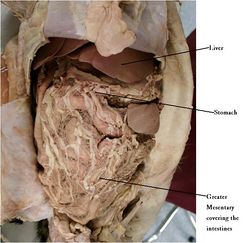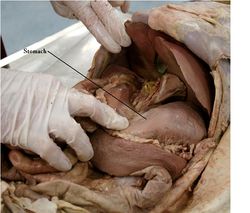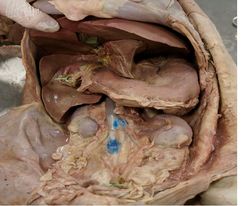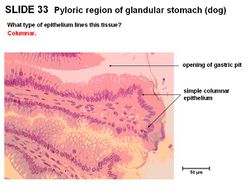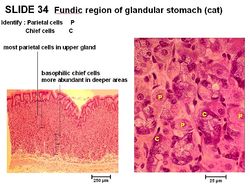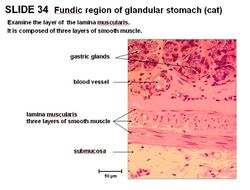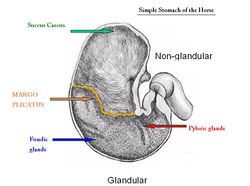Difference between revisions of "Monogastric Stomach - Anatomy & Physiology"
Fiorecastro (talk | contribs) |
(→Links) |
||
| (11 intermediate revisions by 6 users not shown) | |||
| Line 1: | Line 1: | ||
| − | |||
==Overview== | ==Overview== | ||
[[Image:Stomach Anatomy 1.jpg|thumb|right|250px|Stomach Anatomy 1 - Copyright Nottingham 2008]] | [[Image:Stomach Anatomy 1.jpg|thumb|right|250px|Stomach Anatomy 1 - Copyright Nottingham 2008]] | ||
| Line 95: | Line 94: | ||
[[Image:Margo Plicatus.jpg|thumb|right|250px|Equine Stomch with Margo Plicatus - Copyright RVC 2008]] | [[Image:Margo Plicatus.jpg|thumb|right|250px|Equine Stomch with Margo Plicatus - Copyright RVC 2008]] | ||
| − | === | + | ===Equine=== |
A region called the '''margo plicatus''' is present which separates the glandular and non-glandular parts of the equine stomach. The non-glandular area is lined with squamous epithelium (not columnar). | A region called the '''margo plicatus''' is present which separates the glandular and non-glandular parts of the equine stomach. The non-glandular area is lined with squamous epithelium (not columnar). | ||
The stomach is relatively small (10% GIT) with a strong '''cardiac sphincter''' which prevents the animal from [[Vomiting|vomiting]]. The equine stomach is rarely empty, retention time is short and expulsion into the [[Duodenum - Anatomy & Physiology|duodenum]] stops when feeding stops. A 500kg horse can produce 30l of gastric juice in 24 hours. | The stomach is relatively small (10% GIT) with a strong '''cardiac sphincter''' which prevents the animal from [[Vomiting|vomiting]]. The equine stomach is rarely empty, retention time is short and expulsion into the [[Duodenum - Anatomy & Physiology|duodenum]] stops when feeding stops. A 500kg horse can produce 30l of gastric juice in 24 hours. | ||
| Line 115: | Line 114: | ||
|dragster =[[Comparative Stomach Anatomy Dragster resources]] | |dragster =[[Comparative Stomach Anatomy Dragster resources]] | ||
|flashcards = [[Monogastric Stomach - Anatomy & Physiology - Flashcards]] | |flashcards = [[Monogastric Stomach - Anatomy & Physiology - Flashcards]] | ||
| − | |videos =[[Canine Abdomen video|The Canine Abdomen | + | |videos =[[Canine Abdomen video|The Canine Abdomen]]<br>[http://stream2.rvc.ac.uk/Anatomy/equine/Pony_abdomen.mp4 Lateral View of the Equine Abdomen]<br>[http://stream2.rvc.ac.uk/Frean/Pony/left_topography.mp4 Left Sided topography of the Equine abdomen]<br>[http://stream2.rvc.ac.uk/Frean/Pony/right_topography.mp4 Right sided topography of the Equine Abdomen]<br>[http://stream2.rvc.ac.uk/Anatomy/equine/Pot0039.mp4 The Equine Stomach]<br>[http://stream2.rvc.ac.uk/Frean/sheep/LeftSideTopography.mp4 Left sided topography of the Ovine Abdomen and Thorax]<br>[http://stream2.rvc.ac.uk/Frean/sheep/RightSideTopography.mp4 Right sided topography of the Ovine Abdomen]<br>[http://stream2.rvc.ac.uk/Anatomy/feline/pot0357.mp4 The Feline Abdomen]<br>[http://stream2.rvc.ac.uk/Anatomy/swine/Pig_abdomen.mp4 The Porcine Abdomen] |
| − | |||
| − | |||
| − | |||
}} | }} | ||
| − | |||
| − | |||
[[Category:Stomach - Anatomy & Physiology]] | [[Category:Stomach - Anatomy & Physiology]] | ||
[[Category:A&P Done]] | [[Category:A&P Done]] | ||
Revision as of 17:31, 23 May 2011
Overview
The enlarged swelling of the gastrointestinal tract between the oesophagus and the duodenum is called the stomach. It is a simple structure in carnivores and a compound structure in ruminants.
The stomach functions as a reservoir of food where digestion occurs through chemical and mechanical processes. This allows food to be broken down further and absorbed.
Development
The gut tube is formed from the folding of the splanchnopleure (mesoderm and endoderm). The endoderm is the inner layer forming the epithelia and glands. The layers around it are from the mesoderm forming the skeletal muscle, (oesophagus and anus), smooth muscle (from lateral plate mesoderm) and connective tissue.
The region enlarges and a swelling indicates where the stomach will form. The dorsal surface becomes convex to form the greater curvature of the stomach and the ventral surface becomes concave to form the lesser curvature. Two rotations of 90 degrees occur along the longitudinal axis and then the dorso-ventral axis. The dorsal mesogastrium becomes elongated (with the spleen) and expands into a large fold along the ventral abdominal wall. This becomes the greater omentum which covers all the abdominal organs. It is a superficial structure which is free to move. The ventral mesogastrium becomes the lesser omentum. It is in between the stomach and the liver. The rest of the ventral mesentry degenerates.
Structure and Function
The stomach is split into regions: cardia, fundic, body and pyloric. The entire stomach is motile. It has a pH of 0.9 to 1.5.
The larger part of the stomach lies to the left of the midline, under cover from the ribcage and in contact with the liver and diaphragm. The oesophagus opens into it at the cardiac sphincter. The smaller part of the stomach has thicker walls and passes to the right of the midline into the duodenum at the pyloric sphincter. The angular point between the two parts of the stomach is called the angular notch (incisura).
The fundus is a blind dome rising above the cardia. The body extends from the cardia ventrally and the pyloric part is on the right divided into a more muscular and a less muscular half. The serosa (external peritoneum) covers the entire organ.
Contractions start near the cardia and spread distally, accelerating and becoming more vigorous as they reach the pyloric region. The pyloric sphincter is open for 1/3 of the time during contractions. The empty stomach lies completely within the rib cage and does not contact the abdominal floor. Little secretion is produced and only small peristaltic contractions occur. Once food is offered or anticipated, the secretions begin.
The stomach is supported by 4 folds of peritoneum:
- Gastrophrenic ligament - from the greater curvature of the stomach to the crura of the diaphragm
- Lesser omentum- connecting the lesser curvature of the stomach and the initial segment of duodenum to the liver in the region of the hepatic porta
- Gastrosplenic ligament- connecting the greater curvature of the stomach to the spleen by a double fold of peritoneum
- Greater omentum- connecting the greater curvature of the stomach to the duodenum and dorsal body wall
Vasculature
Vasculature of the stomach includes the coeliac artery (which is a branch of the dorsal aorta). The coeliac artery splits into the hepatic artery supplying the liver, pancreas and stomach (right gastric and right gastro-epiploic arteries). The coeliac artery also splits into the splenic artery which supplies the spleen and the stomach (left gastro-epiploic artery), it also splits into the left gastric artery supplying the stomach.
The gastro-epiploic arteries supply the greater curvature of the stomach and the gastric arteries supply the lesser curvature of the stomach. The numerous veins join the portal vein.
Innervation
Sympathetic fibres run with the arteries. Parasympathetic fibres from the vagus nerve (CN X) are within the two vagal trunks. In the proximal region of the stomach, vagal stimulation suppresses muscular contraction (VIP) and in the distal region, vagal stimulation increases muscular activity (ACh).
Histology
The monogastric stomach has a columnar epithelium. The folded mucosa of the stomach forms longitudinal rugae. The folds form invaginations called gastric pits which are continuous with gastric glands.
Layers of the stomach
The 4 layers of the stomach wall are:
- Serosa/adventitia
- Tunica muscularis
- Submucosa
- Mucosa
There are 3 layers of muscularis: the outer longitudinal, middle circular and inner oblique. The pyloric sphincter is a thickened tunica muscularis from the middle circular smooth muscle layer. In the fundic region, the tunica muscularis is thinner, the glands are straight and the gastric pits are shallow. There is also an abundance of parietal and chief cells in the gland. In the pyloric region, the tunica muscularis is thicker, the glands are coiled and the gastric pits are deep. The cardia is a narrow muscle strip. Lymphatic vessels are present in the submucosa.
Cell types
The stomach contains basophilic chief (zygomatic) cells that secrete pepsinogen in response to vagus nerve stimulation and gastrin release. Pepsinogen unfolds and cleaves itself (autocatalyses) in response to hydrochloric acid, therefore only in acidic environments.
The stomach also contains goblet cells that secrete mucous. This secretion protects against autodigestion.
There are also parietal (oxyntic) cells found in gastric pits that secrete hydrochloric acid. This secretion aids digestion by activating gastric enzymes, e.g. pepsinogen to pepsin. Hydrochloric acid kills microorganisms and enzymes that enter with food. Hydrochloric acid is secreted in response to vagus nerve stimulation or pepsin secretion. Parietal cells are large and pyramid shaped, with a higher abundance in the upper region of the glands.
Gastrin is released from pyloric G cells; Somatostatin is released from pyloric D cells and histamine is released from Enterochromaffin-like cells (ECL cells).
Stomach glands are short, coiled, branched and tubular. They need to be replaced due to wear and tear and are only found in the mucosal layer.
Digestive Enzymes
The digestive enzymes include;
Proteases
They are secreted as an inactive zymogen, activated by hydrochloric acid. Active pepsin is produced and completed near the brush border to generate small peptides and individual amino acids. It starts in the stomach and continues into the small intestine.
Carbohydrases
Carbohydrases, e.g. amylase, are within salivary and pancreatic secretions and act to produce disaccharides. Disaccharides are converted to monosaccharides near the brush border. Cellulases are digested by symbiotic micro-organisms in the (ruminant stomachs).
Lipases
Lipases are assisted by bile salts which neutralise stomach acids and emulsifies fats. The process generates free fatty acids, monoglycerides and diglycerides.
Control of secretions
The release of gastric secretions is under hormonal (gastrin), paracrine (histamine) and neural (ACh) mediator control in the cephalic and gastric phases. Gastric secretions are inhibited during the intestinal phase by CCK and secretin.
For more information, see control of secretions.
Species Differences
The size of the non-glandular region in the simple stomach varies between species. It is largest in the horse, pig and then smallest in the dog.
Equine
A region called the margo plicatus is present which separates the glandular and non-glandular parts of the equine stomach. The non-glandular area is lined with squamous epithelium (not columnar). The stomach is relatively small (10% GIT) with a strong cardiac sphincter which prevents the animal from vomiting. The equine stomach is rarely empty, retention time is short and expulsion into the duodenum stops when feeding stops. A 500kg horse can produce 30l of gastric juice in 24 hours.
Canine
The stomach is of variable size ranging from 0.5 to 6l according to breed. A full stomach can touch the bladder. The subglandular layer of fibroblasts and collagen fibres are for protection, e.g. from consuming bones. It is between the glands and the lamina muscularis. A 25kg dog can produce 0.5 to 1l gastric juice in 24 hours.
Porcine
The cardia is thickened, taking up nearly half the area of the stomach. The internal diverticulum is present, which can be seen externally.
Links
Click here for Stomach Pathology.
Click here for Control of Feeding.
| Monogastric Stomach - Anatomy & Physiology Learning Resources | |
|---|---|
 Test your knowledge using drag and drop boxes |
Comparative Stomach Anatomy Dragster resources |
 Test your knowledge using flashcard type questions |
Monogastric Stomach - Anatomy & Physiology - Flashcards |
 Selection of relevant videos |
The Canine Abdomen Lateral View of the Equine Abdomen Left Sided topography of the Equine abdomen Right sided topography of the Equine Abdomen The Equine Stomach Left sided topography of the Ovine Abdomen and Thorax Right sided topography of the Ovine Abdomen The Feline Abdomen The Porcine Abdomen |
